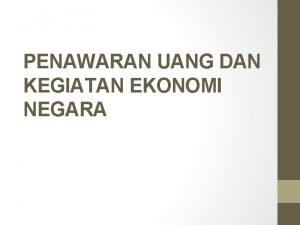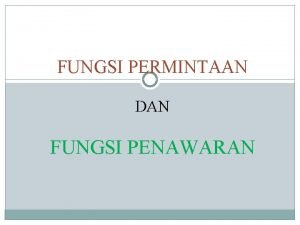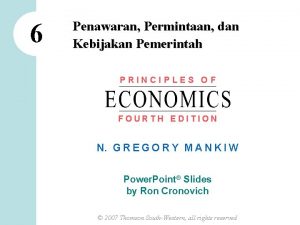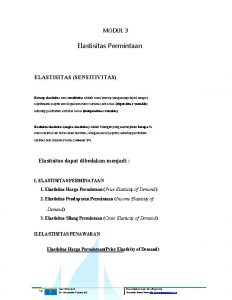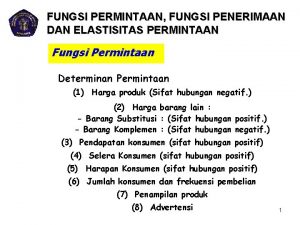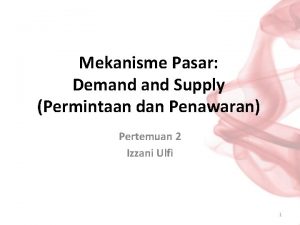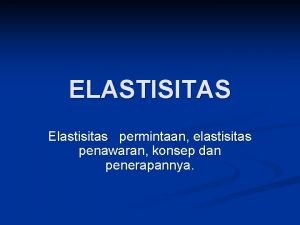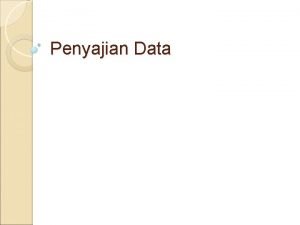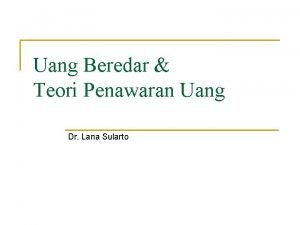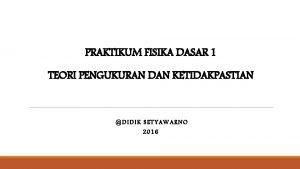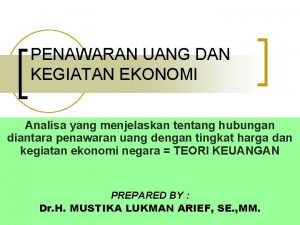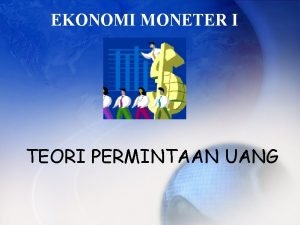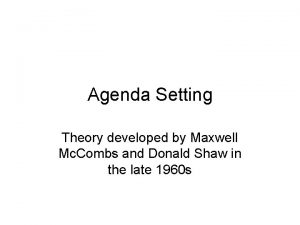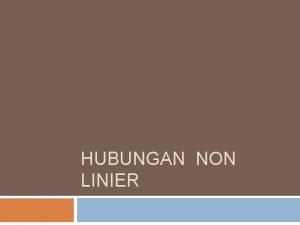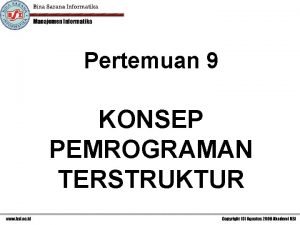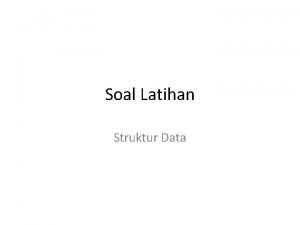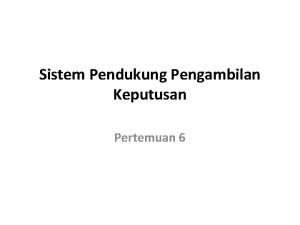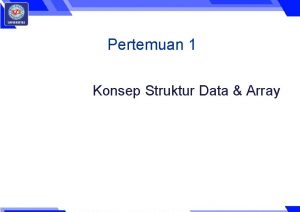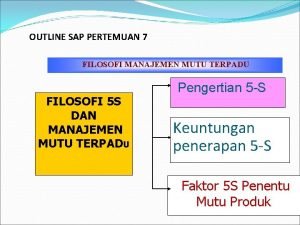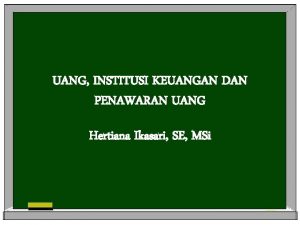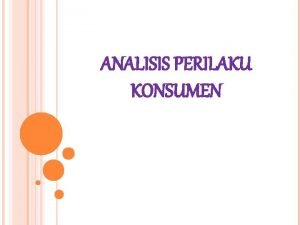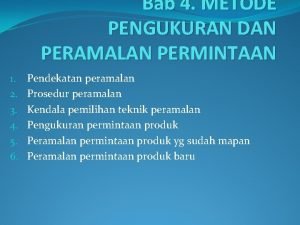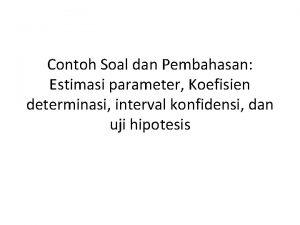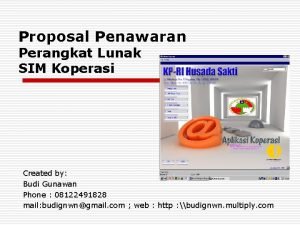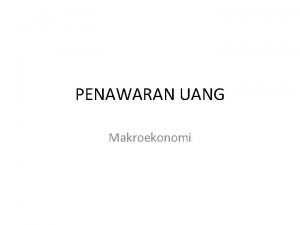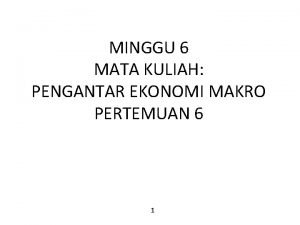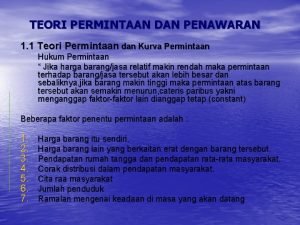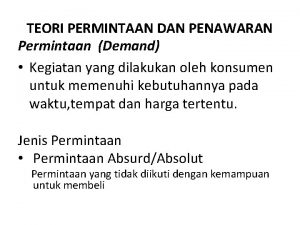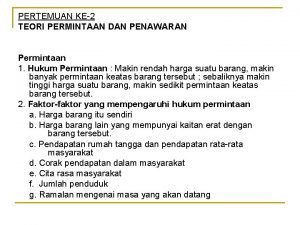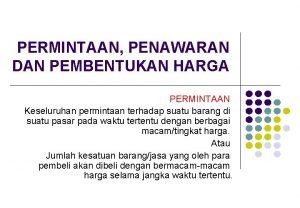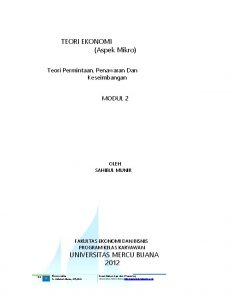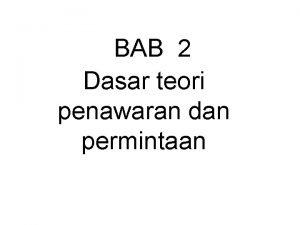Pertemuan 2 TEORI PERMINTAAN DAN PENAWARAN AGENDA Demand


































































































- Slides: 98

Pertemuan 2 TEORI PERMINTAAN DAN PENAWARAN

AGENDA �Demand �Supply �Equilibrium

DEMAND � Quantity demanded is the amount of a good that buyers are willing and able to purchase. � Law of Demand � The law of demand states that, other things equal, the quantity demanded of a good falls when the price of the good rises.

THE DEMAND CURVE: THE RELATIONSHIP BETWEEN PRICE AND QUANTITY DEMANDED � Demand � The Schedule demand schedule is a table that shows the relationship between the price of the good and the quantity demanded.

CATHERINE’S DEMAND SCHEDULE

THE DEMAND CURVE: THE RELATIONSHIP BETWEEN PRICE AND QUANTITY DEMANDED � Demand � The Curve demand curve is a graph of the relationship between the price of a good and the quantity demanded.

FIGURE 1 CATHERINE’S DEMAND SCHEDULE AND DEMAND CURVE Price of Ice-Cream Cone $3. 00 2. 50 1. A decrease 2. 00 in price. . . 1. 50 1. 00 0. 50 0 1 2 3 4 5 6 7 8 9 10 11 12 Quantity of Ice-Cream Cones 2. . increases quantity of cones demanded. Copyright © 2004 South-Western

MARKET DEMAND VERSUS INDIVIDUAL DEMAND � Market demand refers to the sum of all individual demands for a particular good or service. � Graphically, individual demand curves are summed horizontally to obtain the market demand curve.

SHIFTS IN THE DEMAND CURVE � Change in Quantity Demanded � Movement along the demand curve. � Caused by a change in the price of the product.

CHANGES IN QUANTITY DEMANDED Price of Ice. Cream Cones B $2. 00 A tax that raises the price of icecream cones results in a movement along the demand curve. A 1. 00 D 0 4 8 Quantity of Ice-Cream Cones

SHIFTS IN THE DEMAND CURVE � Consumer income � Prices of related goods � Tastes � Expectations � Number of buyers

SHIFTS IN THE DEMAND CURVE � Change �A in Demand shift in the demand curve, either to the left or right. � Caused by any change that alters the quantity demanded at every price.

FIGURE 3 SHIFTS IN THE DEMAND CURVE Price of Ice-Cream Cone Increase in demand Demand curve, D 3 0 Demand curve, D 1 Demand curve, D 2 Quantity of Ice-Cream Cones

SHIFTS IN THE DEMAND CURVE � Consumer � As Income increases the demand for a normal good will increase. � As income increases the demand for an inferior good will decrease.

CONSUMER INCOME NORMAL GOOD Price of Ice. Cream Cone An increase in income. . . $3. 00 2. 50 Increase in demand 2. 00 1. 50 1. 00 0. 50 D 1 0 1 2 3 4 5 6 7 8 9 10 11 12 D 2 Quantity of Ice-Cream Cones

CONSUMER INCOME INFERIOR GOOD Price of Ice. Cream Cone $3. 00 An increase in income. . . 2. 50 2. 00 Decrease in demand 1. 50 1. 00 0. 50 D 2 0 1 D 1 2 3 4 5 6 7 8 9 10 11 12 Quantity of Ice-Cream Cones

SHIFTS IN THE DEMAND CURVE � Prices of Related Goods � When a fall in the price of one good reduces the demand for another good, the two goods are called substitutes. � When a fall in the price of one good increases the demand for another good, the two goods are called complements.

TABLE 1 VARIABLES THAT INFLUENCE BUYERS

SUPPLY � Quantity supplied is the amount of a good that sellers are willing and able to sell. � Law of Supply � The law of supply states that, other things equal, the quantity supplied of a good rises when the price of the good rises.

THE SUPPLY CURVE: THE RELATIONSHIP BETWEEN PRICE AND QUANTITY SUPPLIED � Supply � The Schedule supply schedule is a table that shows the relationship between the price of the good and the quantity supplied.

BEN’S SUPPLY SCHEDULE

THE SUPPLY CURVE: THE RELATIONSHIP BETWEEN PRICE AND QUANTITY SUPPLIED � Supply � The Curve supply curve is the graph of the relationship between the price of a good and the quantity supplied.

FIGURE 5 BEN’S SUPPLY SCHEDULE AND SUPPLY CURVE Price of Ice-Cream Cone $3. 00 1. An increase in price. . . 2. 50 2. 00 1. 50 1. 00 0. 50 0 1 2 3 4 5 6 7 8 9 10 11 12 Quantity of Ice-Cream Cones 2. . increases quantity of cones supplied.

MARKET SUPPLY VERSUS INDIVIDUAL SUPPLY � Market supply refers to the sum of all individual supplies for all sellers of a particular good or service. � Graphically, individual supply curves are summed horizontally to obtain the market supply curve.

SHIFTS IN THE SUPPLY CURVE � Input prices � Technology � Expectations � Number of sellers

SHIFTS IN THE SUPPLY CURVE � Change in Quantity Supplied � Movement along the supply curve. � Caused by a change in anything that alters the quantity supplied at each price.

CHANGE IN QUANTITY SUPPLIED Price of Ice. Cream Cone S C $3. 00 A rise in the price of ice cream cones results in a movement along the supply curve. A 1. 00 0 1 5 Quantity of Ice-Cream Cones

SHIFTS IN THE SUPPLY CURVE � Change �A in Supply shift in the supply curve, either to the left or right. � Caused by a change in a determinant other than price.

FIGURE 7 SHIFTS IN THE SUPPLY CURVE Price of Ice-Cream Cone Supply curve, S 3 Decrease in supply Supply curve, S 1 Supply curve, S 2 Increase in supply 0 Quantity of Ice-Cream Cones

TABLE 2 VARIABLES THAT INFLUENCE SELLERS

SUPPLY AND DEMAND TOGETHER � Equilibrium refers to a situation in which the price has reached the level where quantity supplied equals quantity demanded.

SUPPLY AND DEMAND TOGETHER � Equilibrium Price � The price that balances quantity supplied and quantity demanded. � On a graph, it is the price at which the supply and demand curves intersect. � Equilibrium � The Quantity quantity supplied and the quantity demanded at the equilibrium price. � On a graph it is the quantity at which the supply and demand curves intersect.

SUPPLY AND DEMAND TOGETHER Demand Schedule Supply Schedule At $2. 00, the quantity demanded is equal to the quantity supplied!

FIGURE 8 THE EQUILIBRIUM OF SUPPLY AND DEMAND Price of Ice-Cream Cone Supply $2. 00 Equilibrium price Equilibrium quantity 0 1 2 3 4 5 6 7 8 Demand 9 10 11 12 13 Quantity of Ice-Cream Cones

FIGURE 9 MARKETS NOT IN EQUILIBRIUM (a) Excess Supply Price of Ice-Cream Cone Surplus Supply $2. 50 2. 00 Demand 0 4 Quantity demanded 7 10 Quantity of Quantity Ice-Cream supplied Cones

EQUILIBRIUM � Surplus � When price > equilibrium price, then quantity supplied > quantity demanded. � There is excess supply or a surplus. � Suppliers will lower the price to increase sales, thereby moving toward equilibrium.

EQUILIBRIUM � Shortage � When price < equilibrium price, then quantity demanded > the quantity supplied. � There is excess demand or a shortage. � Suppliers will raise the price due to too many buyers chasing too few goods, thereby moving toward equilibrium.

FIGURE 9 MARKETS NOT IN EQUILIBRIUM (b) Excess Demand Price of Ice-Cream Cone Supply $2. 00 1. 50 Shortage Demand 0 4 Quantity supplied 7 10 Quantity of Quantity Ice-Cream demanded Cones

EQUILIBRIUM � Law of supply and demand � The claim that the price of any good adjusts to bring the quantity supplied and the quantity demanded for that good into balance.

THREE STEPS TO ANALYZING CHANGES IN EQUILIBRIUM � Decide whether the event shifts the supply or demand curve (or both). � Decide whether the curve(s) shift(s) to the left or to the right. � Use the supply-and-demand diagram to see how the shift affects equilibrium price and quantity.

FIGURE 10 HOW AN INCREASE IN DEMAND AFFECTS THE EQUILIBRIUM Price of Ice-Cream Cone 1. Hot weather increases the demand for ice cream. . . Supply New equilibrium $2. 50 2. 00 2. . resulting in a higher price. . . Initial equilibrium D D 0 3. . and a higher quantity sold. 7 10 Quantity of Ice-Cream Cones

THREE STEPS TO ANALYZING CHANGES IN EQUILIBRIUM � Shifts in Curves versus Movements along Curves �A shift in the supply curve is called a change in supply. � A movement along a fixed supply curve is called a change in quantity supplied. � A shift in the demand curve is called a change in demand. � A movement along a fixed demand curve is called a change in quantity demanded.

FIGURE 11 HOW A DECREASE IN SUPPLY AFFECTS THE EQUILIBRIUM Price of Ice-Cream Cone S 2 1. An increase in the price of sugar reduces the supply of ice cream. . . S 1 New equilibrium $2. 50 Initial equilibrium 2. 00 2. . resulting in a higher price of ice cream. . . 0 Demand 4 7 3. . and a lower quantity sold. Quantity of Ice-Cream Cones

TABLE 4 WHAT HAPPENS TO PRICE AND QUANTITY WHEN SUPPLY OR DEMAND SHIFTS? Copyright© 2004 South-Western

ELASTICITY. . . � … allows us to analyze supply and demand with greater precision. �… is a measure of how much buyers and sellers respond to changes in market conditions

THE ELASTICITY OF DEMAND � Price elasticity of demand is a measure of how much the quantity demanded of a good responds to a change in the price of that good. � Price elasticity of demand is the percentage change in quantity demanded given a percent change in the price.

THE PRICE ELASTICITY OF DEMAND ITS DETERMINANTS � Availability of Close Substitutes � Necessities versus Luxuries � Definition of the Market � Time Horizon

THE PRICE ELASTICITY OF DEMAND ITS DETERMINANTS � Demand � the tends to be more elastic : larger the number of close substitutes. � if the good is a luxury. � the more narrowly defined the market. � the longer the time period.

COMPUTING THE PRICE ELASTICITY OF DEMAND � The price elasticity of demand is computed as the percentage change in the quantity demanded divided by the percentage change in price.

COMPUTING THE PRICE ELASTICITY OF DEMAND � Example: If the price of an ice cream cone increases from $2. 00 to $2. 20 and the amount you buy falls from 10 to 8 cones, then your elasticity of demand would be calculated as:

THE MIDPOINT METHOD: A BETTER WAY TO CALCULATE PERCENTAGE CHANGES AND ELASTICITIES � The midpoint formula is preferable when calculating the price elasticity of demand because it gives the same answer regardless of the direction of the change.

THE MIDPOINT METHOD: A BETTER WAY TO CALCULATE PERCENTAGE CHANGES AND ELASTICITIES � Example: If the price of an ice cream cone increases from $2. 00 to $2. 20 and the amount you buy falls from 10 to 8 cones, then your elasticity of demand, using the midpoint formula, would be calculated as:

THE VARIETY OF DEMAND CURVES � Inelastic Demand � Quantity demanded does not respond strongly to price changes. � Price elasticity of demand is less than one. � Elastic Demand � Quantity demanded responds strongly to changes in price. � Price elasticity of demand is greater than one.

COMPUTING THE PRICE ELASTICITY OF DEMAND Price $5 4 0 Demand 50 100 Quantity Demand is price elastic

THE VARIETY OF DEMAND CURVES � Perfectly Inelastic � Quantity demanded does not respond to price changes. � Perfectly Elastic � Quantity demanded changes infinitely with any change in price. � Unit Elastic � Quantity demanded changes by the same percentage as the price.

FIGURE 1 THE PRICE ELASTICITY OF DEMAND (a) Perfectly Inelastic Demand: Elasticity Equals 0 Price Demand $5 4 1. An increase in price. . . 0 100 Quantity 2. . leaves the quantity demanded unchanged.

FIGURE 1 THE PRICE ELASTICITY OF DEMAND (b) Inelastic Demand: Elasticity Is Less Than 1 Price $5 4 1. A 22% increase in price. . . Demand 0 90 100 Quantity 2. . leads to an 11% decrease in quantity demanded.

FIGURE 1 THE PRICE ELASTICITY OF DEMAND (c) Unit Elastic Demand: Elasticity Equals 1 Price $5 4 Demand 1. A 22% increase in price. . . 0 80 100 Quantity 2. . leads to a 22% decrease in quantity demanded.

FIGURE 1 THE PRICE ELASTICITY OF DEMAND (d) Elastic Demand: Elasticity Is Greater Than 1 Price $5 4 Demand 1. A 22% increase in price. . . 0 50 100 Quantity 2. . leads to a 67% decrease in quantity demanded.

FIGURE 1 THE PRICE ELASTICITY OF DEMAND (e) Perfectly Elastic Demand: Elasticity Equals Infinity Price 1. At any price above $4, quantity demanded is zero. $4 Demand 2. At exactly $4, consumers will buy any quantity. 0 3. At a price below $4, quantity demanded is infinite. Quantity

Nilai >1 =1 <1 Keterangan Implikasi Elastis % perubahan Q > % perubahan P Unitary Elastis % perubahan Q = % perubahan P Inelastis % perubahan Q < % perubahan P

TOTAL REVENUE AND THE PRICE ELASTICITY OF DEMAND � Total revenue is the amount paid by buyers and received by sellers of a good. � Computed as the price of the good times the quantity sold. TR = P x Q

FIGURE 2 TOTAL REVENUE Price $4 P × Q = $400 (revenue) P Demand 100 0 Q Quantity

ELASTICITY AND TOTAL REVENUE ALONG A LINEAR DEMAND CURVE � With an inelastic demand curve, an increase in price leads to a decrease in quantity that is proportionately smaller. Thus, total revenue increases.

FIGURE 3 HOW TOTAL REVENUE CHANGES WHEN PRICE CHANGES: INELASTIC DEMAND Price An Increase in price from $1 to $3 … … leads to an Increase in total revenue from $100 to $240 $3 Revenue = $240 $1 0 Demand Revenue = $100 Quantity 0 80 Quantity

ELASTICITY AND TOTAL REVENUE ALONG A LINEAR DEMAND CURVE � With an elastic demand curve, an increase in the price leads to a decrease in quantity demanded that is proportionately larger. Thus, total revenue decreases.

FIGURE 4 HOW TOTAL REVENUE CHANGES WHEN PRICE CHANGES: ELASTIC DEMAND Price An Increase in price from $4 to $5 … … leads to an decrease in total revenue from $200 to $100 $5 $4 Demand Revenue = $200 0 50 Revenue = $100 Quantity 0 20 Quantity

ELASTICITY OF A LINEAR DEMAND CURVE

INCOME ELASTICITY OF DEMAND � Income elasticity of demand measures how much the quantity demanded of a good responds to a change in consumers’ income. � It is computed as the percentage change in the quantity demanded divided by the percentage change in income.

COMPUTING INCOME ELASTICITY

INCOME ELASTICITY � Types of Goods � Normal Goods � Inferior Goods � Higher income raises the quantity demanded for normal goods but lowers the quantity demanded for inferior goods.

INCOME ELASTICITY � Goods consumers regard as necessities tend to be income inelastic � Examples include food, fuel, clothing, utilities, and medical services. � Goods consumers regard as luxuries tend to be income elastic. � Examples include sports cars, furs, and expensive foods.

IMPLIKASI Nilai Golongan Barang interprestasi Positif Income-Normal barang normal, kenaikan pendapatan akan berpengaruh dengan kenaikan jumlah barang yang diminta. Nol Income-Independen barang netral, kenaikan / penurunan pendapatan tidak berpengaruh terhadap jumlah konsumsi Negatif Income-Inferior konsumsi akan

CROSS ELASTICITY � Cross elasticity of demand measures how much the quantity demanded of a good responds to a change in the other price. � It is computed as the percentage change in the quantity demanded divided by the percentage change in the other price

COMPUTING CROSS ELASTICITY = % Change in Quantity Demanded Y % Change in The Other Price (X)

IMPLIKASI NILAI Positif JENIS BARANG Subtitusi IMPLIKASI Barang-barang bisa saling mengganti satu sama lain Nol Independen Barang-barang tersebut tidak berhubungan dalam pengkonsumsiannya Negatif Komplementer Barang-barang tersebut dikonsumsi secara bersama-

THE ELASTICITY OF SUPPLY � Price elasticity of supply is a measure of how much the quantity supplied of a good responds to a change in the price of that good. � Price elasticity of supply is the percentage change in quantity supplied resulting from a percent change in price.

FIGURE 6 THE PRICE ELASTICITY OF SUPPLY (a) Perfectly Inelastic Supply: Elasticity Equals 0 Price Supply $5 4 1. An increase in price. . . 0 100 Quantity 2. . leaves the quantity supplied unchanged.

FIGURE 6 THE PRICE ELASTICITY OF SUPPLY (b) Inelastic Supply: Elasticity Is Less Than 1 Price Supply $5 4 1. A 22% increase in price. . . 0 100 110 Quantity 2. . leads to a 10% increase in quantity supplied.

FIGURE 6 THE PRICE ELASTICITY OF SUPPLY (c) Unit Elastic Supply: Elasticity Equals 1 Price Supply $5 4 1. A 22% increase in price. . . 0 100 125 Quantity 2. . leads to a 22% increase in quantity supplied.

FIGURE 6 THE PRICE ELASTICITY OF SUPPLY (d) Elastic Supply: Elasticity Is Greater Than 1 Price Supply $5 4 1. A 22% increase in price. . . 0 100 200 Quantity 2. . leads to a 67% increase in quantity supplied.

FIGURE 6 THE PRICE ELASTICITY OF SUPPLY (e) Perfectly Elastic Supply: Elasticity Equals Infinity Price 1. At any price above $4, quantity supplied is infinite. $4 Supply 2. At exactly $4, producers will supply any quantity. 0 3. At a price below $4, quantity supplied is zero. Quantity

DETERMINANTS OF ELASTICITY OF SUPPLY � Ability of sellers to change the amount of the good they produce. � Beach-front land is inelastic. � Books, cars, or manufactured goods are elastic. � Time period. � Supply is more elastic in the long run.

COMPUTING THE PRICE ELASTICITY OF SUPPLY � The price elasticity of supply is computed as the percentage change in the quantity supplied divided by the percentage change in price.

THE APPLICATION OF SUPPLY, DEMAND, AND ELASTICITY � Examine whether the supply or demand curve shifts. � Determine the direction of the shift of the curve. � Use the supply-and-demand diagram to see how the market equilibrium changes.

FIGURE 8 AN INCREASE IN SUPPLY IN THE MARKET FOR WHEAT Price of Wheat 2. . leads to a large fall in price. . . 1. When demand is inelastic, an increase in supply. . . S 1 S 2 $3 2 Demand 0 100 110 Quantity of Wheat 3. . and a proportionately smaller increase in quantity sold. As a result, revenue falls from $300 to $220.

ELASTICITY AND TAX INCIDENCE � Tax incidence is the manner in which the burden of a tax is shared among participants in a market.

ELASTICITY AND TAX INCIDENCE � Tax incidence is the study of who bears the burden of a tax. � Taxes result in a change in market equilibrium. � Buyers pay more and sellers receive less, regardless of whom the tax is levied on.

FIGURE 6 A TAX ON BUYERS Price of Ice-Cream Price Cone buyers pay $3. 30 Price 3. 00 2. 80 without tax Price sellers receive Supply, S 1 Equilibrium without tax Tax ($0. 50) Equilibrium with tax A tax on buyers shifts the demand curve downward by the size of the tax ($0. 50). D 1 D 2 0 90 100 Quantity of Ice-Cream Cones

ELASTICITY AND TAX INCIDENCE � What was the impact of tax? � Taxes discourage market activity. � When a good is taxed, the quantity sold is smaller. � Buyers and sellers share the tax burden.

FIGURE 7 A TAX ON SELLERS Price of Ice-Cream Price Cone buyers pay $3. 30 3. 00 Price 2. 80 without tax S 2 Equilibrium with tax S 1 Tax ($0. 50) A tax on sellers shifts the supply curve upward by the amount of the tax ($0. 50). Equilibrium without tax Price sellers receive Demand, D 1 0 90 100 Quantity of Ice-Cream Cones

PERBEDAAN KONSEP � Menurut Ibnu Taimiyyah, permintaan suatu barang adalah hasrat terhadap sesuatu. � Konsep permintaan merupakan hubungan antara jumlah barang yang diminta dengan berbagai tingkat harga.

HUKUM PERMINTAAN � pada masa zaman sebelum kenabian atau sesudah masa kenabian, sudah ada pemikiran yang menjadi kesepakatan bersama bahwa tinggi rendahnya pemintaan terhadap barang ditentukan oleh harga barang yang bersangkutan. � Abu Yusuf mengatakan “Kadang-kadang makanan melimpah, tetapi tetap mahal dan kadang-kadang makanan sangat sedikit tetapi murah”

LANDASAN FILOSOFI Islam dalam hal ini khususnya perekonomian sangat menjunjung nilai kesederhanaan. Ø norma-norma Islam yang selalu menemani kehidupan manusia yaitu halal dan haram. Ø

IBNU TAIMIYYAH (1263 -1328 M) DALAM KITAB MAJMU’ FATAWA hal-hal yang mempengaruhi terhadap permintaan suatu barang: � Keinginan atau selera masyarakat � Jumlah para peminat (Tullab) � Kualitas pembeli (Al-Mu’awid) � Lemah atau kuatnya kebutuhan terhadap suatu barang. � Besarnya biaya transaksi.

FAKTOR-FAKTOR PENAWARAN DALAM ISLAM � Mashlahah � Keuntungan

PERBEDAAN TEORI PERMINTAAN KONVENSIONAL DENGAN PERMINTAAN ISLAMI Men Islami : Ø Permintaan Islam bukan hanya berasal dari data pengalaman tapi juga berasal dari firman-firman Allah. Ø Konsep permintaan dalam Islam menilai suatu komoditi tidak semuanya bisa untuk dikonsumsi maupun digunakan. Ø Dalam motif permintaan Islam menekankan pada tingkat kebutuhan konsumen terhadap barang

Men Konvensional : Ø ekonomi konvensional filosofi dasarnya terfokus pada tujuan keuntungan dan material. Ø dalam permintaan konvensional, semua komoditi dinilai sama, bisa dikonsumsi atau digunakan. Ø motif permintaan konvensional lebih didominasi oleh nilai-nilai kepuasani.
 Pertanyaan tentang aplikasi teori permintaan dan penawaran
Pertanyaan tentang aplikasi teori permintaan dan penawaran Teori permintaan dan penawaran jasa audit
Teori permintaan dan penawaran jasa audit Jasa non assurance adalah
Jasa non assurance adalah Jurnal penawaran uang dan kegiatan ekonomi negara
Jurnal penawaran uang dan kegiatan ekonomi negara Aplikasi teori permintaan dan penawaran
Aplikasi teori permintaan dan penawaran Penawaran elastis uniter terjadi jika
Penawaran elastis uniter terjadi jika Skedul permintaan
Skedul permintaan Materi ekonomi kelas 10
Materi ekonomi kelas 10 Rumus fungsi penawaran adalah
Rumus fungsi penawaran adalah Penawaran permintaan dan kebijakan pemerintah
Penawaran permintaan dan kebijakan pemerintah Pengertian estimasi
Pengertian estimasi Permintaan dan penawaran jasa transportasi
Permintaan dan penawaran jasa transportasi Teori permintaan ekonomi manajerial
Teori permintaan ekonomi manajerial Kurva permintaan dan penawaran agregat
Kurva permintaan dan penawaran agregat Modul elastisitas permintaan dan penawaran
Modul elastisitas permintaan dan penawaran Kurva permintaan dan penawaran
Kurva permintaan dan penawaran Fungsi penerimaan
Fungsi penerimaan Mekanisme pasar permintaan dan penawaran
Mekanisme pasar permintaan dan penawaran Fungsi penawaran dan permintaan
Fungsi penawaran dan permintaan Konsep elastisitas permintaan dan penawaran
Konsep elastisitas permintaan dan penawaran Dengan asumsi ceteris paribus naiknya
Dengan asumsi ceteris paribus naiknya Surat kenaikan harga barang
Surat kenaikan harga barang Perbedaan teori permintaan uang klasik dan keynes
Perbedaan teori permintaan uang klasik dan keynes Teori permintaan uang menurut keynes
Teori permintaan uang menurut keynes Diagram batang majemuk
Diagram batang majemuk Sel adalah pertemuan antara titik-titik dan titik-titik
Sel adalah pertemuan antara titik-titik dan titik-titik Teori penawaran uang tanpa bank
Teori penawaran uang tanpa bank Independent and dependent demand
Independent and dependent demand Agenda sistemica y agenda institucional
Agenda sistemica y agenda institucional Contoh teori big bang dalam kepemimpinan
Contoh teori big bang dalam kepemimpinan Teori umum dan teori khusus
Teori umum dan teori khusus Dasar teori pengukuran dan ketidakpastian
Dasar teori pengukuran dan ketidakpastian Definisi teori dan teori keperawatan
Definisi teori dan teori keperawatan Teori sisa tunai diterangkan dengan menggunakan persamaan :
Teori sisa tunai diterangkan dengan menggunakan persamaan : Pertanyaan teori permintaan
Pertanyaan teori permintaan Kelemahan teori kuantitas uang
Kelemahan teori kuantitas uang Teori permintaan konsumen
Teori permintaan konsumen Jelaskan teori permintaan uang klasik
Jelaskan teori permintaan uang klasik Kurva engel
Kurva engel Teori agenda setting pertama kali dicetuskan oleh
Teori agenda setting pertama kali dicetuskan oleh Teori agenda setting adalah
Teori agenda setting adalah Teori agenda setting
Teori agenda setting Framing strategy examples
Framing strategy examples Teori agenda setting
Teori agenda setting Tugas pertemuan 9 metode perancangan program
Tugas pertemuan 9 metode perancangan program Pertemuan multikultural
Pertemuan multikultural Pertemuan multikultural
Pertemuan multikultural Denah ruang pertemuan
Denah ruang pertemuan Pleonasme
Pleonasme Tugas statistika pertemuan 2
Tugas statistika pertemuan 2 Pada pertemuan kali ini kita
Pada pertemuan kali ini kita Pertemuan ini
Pertemuan ini Pertemuan 9
Pertemuan 9 Pertemuan awal pkh adalah
Pertemuan awal pkh adalah Pada kondisi awal, tos selalu bernilai
Pada kondisi awal, tos selalu bernilai Spk latihan pertemuan 6
Spk latihan pertemuan 6 Array 3 dimensi
Array 3 dimensi Tipe data yang terdiri dari aksara
Tipe data yang terdiri dari aksara Sell adalah pertemuan antara
Sell adalah pertemuan antara Sukrosa
Sukrosa Logo pertemuan
Logo pertemuan Pengertian etiket
Pengertian etiket Inventory modeling
Inventory modeling Measures to correct excess and deficient demand
Measures to correct excess and deficient demand Market demand curve
Market demand curve Dependent and independent demand in inventory management
Dependent and independent demand in inventory management Bumuo ng isang halimbawa ng demand schedule
Bumuo ng isang halimbawa ng demand schedule Module 5 supply and demand introduction and demand
Module 5 supply and demand introduction and demand Demand estimation methods
Demand estimation methods Paradox of value
Paradox of value Independent demand inventory
Independent demand inventory Institusi keuangan dan penawaran uang
Institusi keuangan dan penawaran uang Kuantitas uang
Kuantitas uang Uang institusi keuangan dan penawaran uang
Uang institusi keuangan dan penawaran uang Materi bab 9 penawaran uang dan kegiatan ekonomi negara
Materi bab 9 penawaran uang dan kegiatan ekonomi negara Model motivasi adalah
Model motivasi adalah Model model motivasi
Model model motivasi Teori tingkah laku konsumen teori nilai guna
Teori tingkah laku konsumen teori nilai guna Teori komputasi dibagi menjadi dua cabang yaitu teori
Teori komputasi dibagi menjadi dua cabang yaitu teori Siklus penganggaran sektor publik
Siklus penganggaran sektor publik Apa arti teori
Apa arti teori Teori perkembangan moral jean piaget
Teori perkembangan moral jean piaget Contoh soal dan jawaban tata bahasa reguler
Contoh soal dan jawaban tata bahasa reguler Bina ayat dengan cis
Bina ayat dengan cis Pengelolaan permintaan dan perencanaan produksi
Pengelolaan permintaan dan perencanaan produksi Makalah penaksiran fungsi permintaan doc
Makalah penaksiran fungsi permintaan doc Prosedur peramalan permintaan
Prosedur peramalan permintaan Contoh layanan ti
Contoh layanan ti Contoh soal koefisien determinasi dan jawaban
Contoh soal koefisien determinasi dan jawaban Bagaimana cara mengukur permintaan pasar ?
Bagaimana cara mengukur permintaan pasar ? Mengukur produktivitas pemasaran
Mengukur produktivitas pemasaran Sebutkan peramalan trafik dan permintaan
Sebutkan peramalan trafik dan permintaan Proposal penawaran perangkat lunak
Proposal penawaran perangkat lunak Tingkat bunga ekuilibrium adalah
Tingkat bunga ekuilibrium adalah Penawaran uang tanpa bank
Penawaran uang tanpa bank Kurva penawaran uang
Kurva penawaran uang New market innovation examples
New market innovation examples Ketidakstabilan
Ketidakstabilan Surat penawaran air mineral
Surat penawaran air mineral



